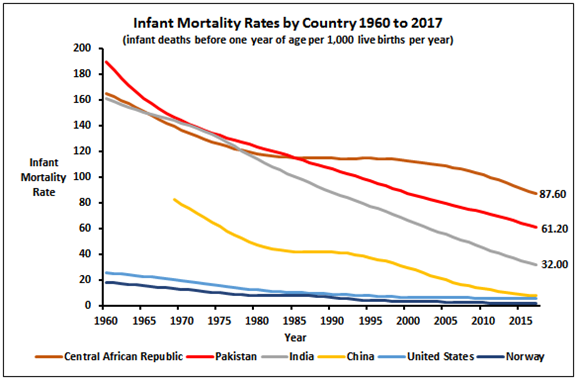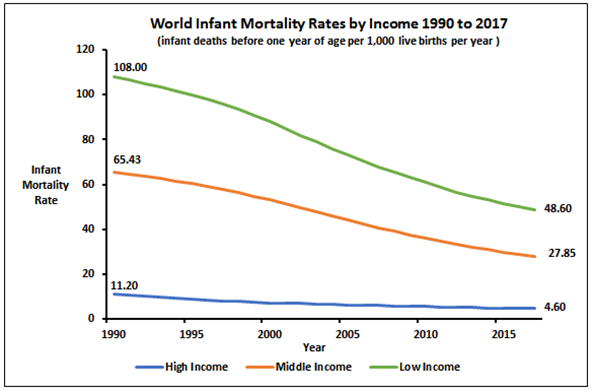Infant Mortality Rate
Revised 24 May 2019
The infant mortality rate is the number of infants dying before reaching one year of age per 1,000 female live births in a given year. Complete annual series of Infant mortality statistics are available for most countries from 1960 to 2017. The infant mortality rates for a selection of countries is shown in Figure 3.

Figure 3: Infant Mortality Rates by Country 1960 to 2017 (Data: United Nations 2019)
The selection of countries in Figure 3 is indicative of the typical extreme differences in infant mortality rates between all countries in 1960 and the substantial closing of the gaps by 2017. For example, in 1960 infant mortality rates for Pakistan and Norway were 189.8 and 18.4 units respectively. By 2017 both previous infant mortality rates had declined to 61.2 and 2.1 units respectively. The initial gap of 171.4 units had closed to a gap of 59.1 units, a reduction to 34.4% of the previous gap.
Of the selection of countries in Figure 3, the largest decline in infant mortality rates occurred in the Central African Republic, Pakistan, India, and China. These countries also had the highest infant mortality rates in 1960. India had the largest recorded decline in infant mortality rates from 161.4 units in 1960 to 32.0 units in 2017, a decline to 19.8% of the previous 1960 level. Statistics for China are not available prior to 1969 for comparison. The United States and Norway had infant mortality rates of 25.9 and 18.4 units in 1960 which respectively declined to 5.7 and 2.1 units by 2017.
The low infant mortality rates of the higher income countries of the United States and Norway and the much higher infant mortality rates of the lower income countries of Central African Republic, Pakistan, and India as shown in Figure 3 are representative of all higher and lower income countries.
Figure 4 shows the infant mortality rates from 1990 to 2017 for all countries separated into low, middle, and high-income groups as classified by the United Nations. This classification is based on a country’s level of development as measured by per capita gross national income (GNI). To maintain compatibility with similar classifications used elsewhere, the threshold levels of GNI per capita are those established by the United Nations. Countries with less than $1,035 GNI per capita are classified as low-income countries, those with between $1,036 $12,615 as middle-income countries, and those with incomes of more than $12,615 as high-income countries.

Figure 4: World Infant Mortality Rates by Income 1990 to 2017 (Data: United Nations 2019)
World infant mortality has declined substantially in middle-income and low-income countries since 1960. Populations of countries with high infant mortality rates tend to grow faster than those countries with low infant mortality rates.